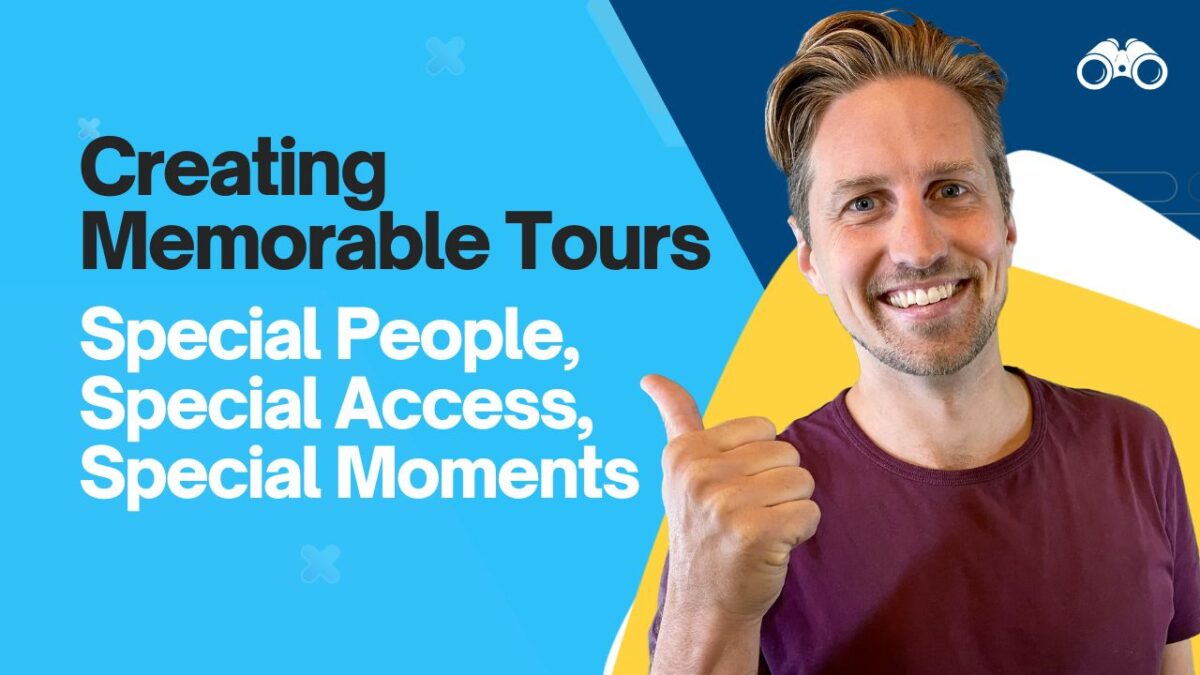
The Unforgettable Product Pyramid: How to Design a Memorable Experience
January 21, 2025
From Boring to Brilliant: The Art of Storytelling on Tour
February 4, 2025Creating Memorable Tours: Special People, Special Access, Special Moments
This is the third in our Tour Design series. Be sure to watch the whole series here!
The French Resistance fighter sat across the table, sharing stories that never made it into history books. His firsthand account of D-Day transformed what could have been a typical Normandy tour into an experience my guests still talked about years later. Time after time, guests said meeting him was the most profound moment of their entire holiday. This is the power of what I call the SPAM framework – and no, it has nothing to do with canned meat.
Creating Unforgettable Tour Experiences: The SPAM Framework
Special People, special Access, and special Moments – these three elements turn good tours into extraordinary experiences that guests rave about. While they often require extra effort to arrange, think of them as investments in creating passionate advocates for your experiences. Let’s break down each element and explore how you can incorporate them into your tours.
Special People: The Heart of Your Tour
The authentic connections with other human beings often become the emotional core of any tour experience. Sometimes the special person is you as the guide, bringing your unique background or local perspective. But the real magic often happens when you facilitate connections with people your guests wouldn’t otherwise meet.
These could be local artisans, community members with unique stories, people with historical connections, or passionate specialists. The key isn’t just finding these special people – it’s creating meaningful interactions that add depth to your tour narrative.
Food tours particularly benefit from these personal connections. A meal becomes more memorable when guests meet the chef and hear their story. In Austin, Texas, I still remember a Moroccan restaurant owner who shared his journey of falling in love and bringing his family’s recipes to Texas. His story transformed a simple meal into a cultural exchange that stuck with me for years.
Small museums and local attractions often have passionate caretakers who bring their spaces to life. In Vietnam’s Mekong Delta, a tiny museum came alive through its charismatic curator. Despite not speaking English, her enthusiasm for demonstrating ancient farming tools created an unforgettable experience that became a highlight of our bike tours.
Special Access: Making Guests Feel Like Insiders
Special access means giving guests experiences they couldn’t have on their own. This is about making people feel like genuine insiders, not just tourists. It might include exclusive entry times, access to private locations, behind-the-scenes perspectives, or unique local-only spaces.
The power lies not just in the access itself, but in how you present it. When guests know they’re experiencing something most visitors won’t see, it adds an extra layer of value to your tour. Take Siena, Italy, where one guide made a theatrical production of using his special key to access private neighborhood chapels and social spaces. His emphasis on the exclusive nature of this access made guests feel privileged and enhanced their entire experience.
Sometimes special access is as simple as knowing when and how to visit popular sites. Companies like Walks have built their success on providing Vatican tours during quiet hours, allowing guests to experience the Sistine Chapel in peaceful contemplation rather than shoulder-to-shoulder crowds.
Special Moments: Crafting Memory Markers
Special moments are carefully crafted sections of your tour where you intentionally create space for something memorable to happen. This is where tour design moves from focusing on what we show to how and when we show it. Think of these as the emotional peaks of your tour – moments designed to leave lasting impressions.
Consider a standard wine tasting in Burgundy. By moving it from a typical tasting room to a candlelit 800-year-old cellar, adding visual aids and expert commentary, the experience becomes incomparable to standard tastings. Similarly, a basic French picnic transformed into a memorable moment by carefully choosing a vineyard viewpoint, adding local wines, creating tiered displays of regional specialties, and playing Edith Piaf in the background.
Craft Experiences That Engage Multiple Senses
The most memorable moments often engage multiple senses. Consider the Sahoji Temple in Kyoto, where visitors begin with silent calligraphy meditation before entering the moss gardens. This thoughtful sequencing creates a state of mindfulness that enhances the entire experience.
In craft workshops, like Jeff’s copper lamp making class, participants don’t just learn a skill – they experience the thrill of controlling fire, the satisfaction of shaping metal, and leave with a physical reminder of their achievement. These sensory-rich experiences create deeper, more lasting memories.
Creating Your Own SPAM Framework
You might be thinking your tour doesn’t have access to resistance fighters or ancient wine cellars. That’s okay – special elements can be as simple as arranging lunch at a local’s farmhouse or getting private access to a neighborhood courtyard most tourists never see. The key is identifying the unique aspects of your local area and connections that you might take for granted.
Consider these reflection points:
- What unique access do you already have that others don’t?
- Who in your community has compelling stories to share?
- Where could you slow down your tour to create space for special moments?
- What physical reminders or tokens could guests take with them?
- How could you engage more senses throughout your experience?
Elevating Existing Tours
Not every tour needs all three SPAM elements, but incorporating even one can significantly enhance your guest experience. Start by auditing your current tours:
- Looking for Special People: Identify the characters in your community who could add depth to your tours. These might be local artists, longtime residents, or passionate experts in their field.
- Finding Special Access: Review your local connections and knowledge. What doors could you open that typical tourists can’t? Sometimes it’s as simple as knowing the best time to visit a popular spot or having relationships with local business owners.
- Creating Special Moments: Look for opportunities to slow down and create space for memorable experiences. This might mean rearranging your tour timing, adding sensory elements, or finding new ways to present familiar attractions.
The Implementation Process
Start small. Pick one element of the SPAM framework and experiment with incorporating it into your existing tour. Pay attention to guest reactions and gather feedback. What resonates most strongly? What could be enhanced?
Remember that consistency is key. Once you identify effective special elements, create systems to ensure they can be delivered reliably. This might mean developing relationships with multiple special people, having backup plans for access points, or creating detailed guides for staging special moments.
Measuring Success
The true measure of these enhancements will show in your guest feedback. Look for:
- Specific mentions in reviews
- Guests recommending particular aspects to friends
- Return visitors requesting the same experiences
- Social media shares of special moments
- Word-of-mouth referrals
Remember, creating memorable tours isn’t about having the most spectacular locations or the rarest access. It’s about thoughtfully crafting experiences that connect with guests on a personal level, give them insider perspectives, and create space for genuine moments they’ll remember long after the tour ends.
Ready to start enhancing your tours? Visit guestfocus.com for more resources on creating exceptional guest experiences, including detailed guides on implementing the SPAM framework and case studies from successful tour operators.

